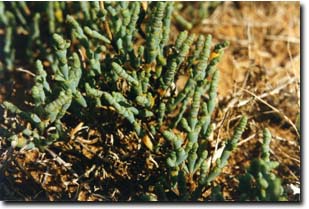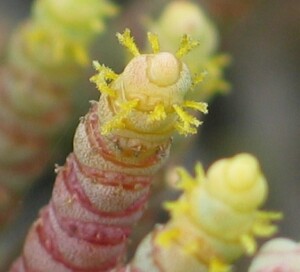Black-seeded Samphire
Back | Salinity Indicator Plants Home | Common name home | Scientific name home | Photo Gallery | Glossary
| Black-seeded Samphire photos | Family: Saltbush (Chenopodiaceae) |
| Scientific Name: | Tecticornia pergranulata (syn. Halosarcia pergranulata, Arthrocnemum halocnemoides var. pergranulatum) |  Black-seeded Samphire Photo: R Clark | ||||||
Other Common Names: | Black-seeded Glasswort, Beadbush | |||||||
Status: | Native to all mainland states of Australia. | |||||||
Plant Description: | A dense succulent shrub with numerous woody stems and short segmented leafless, branchlets made up of small segments, 1-3 mm long and looking like a row of beads. Can grow up to 1 m tall but is often quite a low-growing plant. Flowers and fruiting bodies are 5 cm succulent spikes at the ends of the branchlets. Flowers in spring to early summer. | |||||||
Habitat:: | Grows on clay loams to heavy clays. Found in coastal areas, drainage lines and around salt lakes. It is sometimes found as short red plants in very saline areas.
** sometimes found with S2 plant communities; probably indicative of former higher salinity levels. | |||||||
Comments: | The species of Tecticornia are difficult to separate, particularly without seed. Black-seeded Samphire is the most common species in Victoria but of the nine that occur, the other most common species are T. halocnemoides (Grey Glasswort), T. indica (Brown-head Glasswort) and T. pruinosa (Bluish Glasswort). | |||||||
 Black-seeded Samphire - bush Photo: A J Brown |  Black-seeded Samphire - female flower spikes Photo: A J Brown |
|
Photo: A J Brown |




